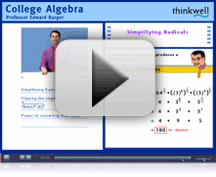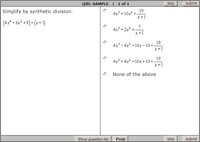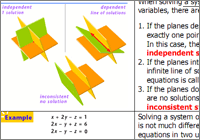College Algebra
Thinkwell's College Algebra with online videos and automatic grading gives your student the algebra help they need. Thinkwell's complete online College Algebra course makes solving algebra problems a breeze.
Thinkwell's video lessons feature award-winning teacher Edward Burger. Students love Professor Burger's ability to break down concepts and explain each example step by step, all while giving them the tips and that make algebra easy for anyone.
Our complete College Algebra package includes:- 12-month Online Subscription to our complete College Algebra course with video lessons, automatically graded algebra problems, and much more.
- Workbook (optional) with lecture notes, sample problems, and exercises so that you can study even when away from the computer.
- CD Set (optional) contains all of the video lessons so that you can watch them when you're away from the internet.
Workbook and CD Sets require the purchase of an online subscription.
Money-Back Guarantee
College Algebra Materials
Online Subscription, 12-month access
Access to a complete online package that includes everything you need:
- High quality video lessons explain all of the College Algebra math topics and concepts
- Automatically graded algebra problems with immediate feedback allow you to track your progress
- Printable full-color illustrated notes help you review what you've learned in the video lesson
- Subscriptions start when you are ready. Buy now and activate your course anytime you like. Wait up to one year to activate your subscription; your 12-month subscription doesn't begin until you say so!
Workbook, Notes, sample problems, exercises, and practice problems
Study without a computer. Our workbook companion contains the same lecture notes and sample problems that are delivered online, as well as some additional exercises, all in a convenient print format. Answers to the odd-numbered exercises are in the back of the book. Online Subscription is required; workbook not sold separately.
CD Set Video Lectures on CD-ROM
This optional CD-ROM set delivers the exact same video lectures delivered online, but without an internet connection. Online Subscription is required; CDs not sold separately. The CDs only contain the videos.
College Algebra Details
Thinkwell's College Algebra has all the features your home school needs:
- More than 100 topics with 400+ engaging video lessons (see sample)
- 750+ interactive exercises with immediate feedback allow you to track your progress
(see sample) - 28 animated interactivities with audio
- Real-world application examples in both lectures and exercises
- Closed captioning for all video lessons
- Glossary of more than 250 mathematical terms
- Brand-new content to help students advance their mathematical knowledge:
- Linear equations, inequalities, and functions
- Linear systems in two and three dimensions
- Matrix operations
- Quadratic functions and complex numbers
- Polynomial, exponential, and logarithmic functions
- Rational and radical functions
- Graphing functions
- Conic sections
- Probability and statistics
- Arithmetic and geometric sequences and series
- Trigonometric functions, graphs, and identities
Table of Contents
(Expand All - Close All)1. Prerequisites
- 1.1 Introduction
- 1.1.1 Introduction to Algebra
- 1.1.2 The Top Ten List of Mistakes
- 1.2 Inequalities
- 1.2.1 Concepts of Inequality
- 1.2.2 Inequalities and Interval Notation
- 1.3 Absolute Value
- 1.3.1 Properties of Absolute Value
- 1.3.2 Evaluating Absolute Value Expressions
- 1.4 Exponents
- 1.4.1 An Introduction to Exponents
- 1.4.2 Evaluating Exponential Expressions
- 1.4.3 Applying the Rules of Exponents
- 1.4.4 Evaluating Expressions with Negative Exponents
- 1.5 Converting between Notations
- 1.5.1 Converting between Decimal and Scientific Notation
- 1.5.2 Converting Rational Exponents and Radicals
- 1.6 Radical Expressions
- 1.6.1 Simplifying Radical Expressions
- 1.6.2 Simplifying Radical Expressions with Variables
- 1.6.3 Rationalizing Denominators
- 1.7 Polynomial Expressions
- 1.7.1 Determining Components and Degree
- 1.7.2 Adding, Subtracting, and Multiplying Polynomials
- 1.7.3 Multiplying Big Products
- 1.7.4 Using Special Products
- 1.8 Factoring
- 1.8.1 Factoring Using the Greatest Common Factor
- 1.8.2 Factoring by Grouping
- 1.8.3 Factoring Trinomials Completely
- 1.8.4 Factoring Trinomials: The Grouping Method
- 1.9 Factoring Patterns
- 1.9.1 Factoring Perfect Square Trinomials
- 1.9.2 Factoring the Difference of Two Squares
- 1.9.3 Factoring Sums and Differences of Cubes
- 1.9.4 Factoring by Any Method
- 1.10 Rational Expressions
- 1.10.1 Rational Expressions and Domain
- 1.10.2 Working with Fractions
- 1.10.3 Writing Rational Expressions in Lowest Terms
- 1.11 Working with Rationals
- 1.11.1 Multiplying and Dividing Rational Expressions
- 1.11.2 Adding and Subtracting Rational Expressions
- 1.11.3 Rewriting Complex Fractions
- 1.12 Complex Numbers
- 1.12.1 Introducing and Writing Complex Numbers
- 1.12.2 Rewriting Powers of i
- 1.12.3 Adding and Subtracting Complex Numbers
- 1.12.4 Multiplying Complex Numbers
- 1.12.5 Dividing Complex Numbers
2. Equations and Inequalities
- 2.1 Linear Equations
- 2.1.1 An Introduction to Solving Equations
- 2.1.2 Solving a Linear Equation
- 2.1.3 Solving a Linear Equation with Rationals
- 2.1.4 Solving a Linear Equation That Has Restrictions
- 2.2 Word Problems with Linear Equations: Math Topics
- 2.2.1 An Introduction to Solving Word Problems
- 2.2.2 Solving for Perimeter
- 2.2.3 Solving a Linear Geometry Problem
- 2.2.4 Solving for Consecutive Numbers
- 2.2.5 Solving to Find the Average
- 2.3 Word Problems with Linear Equations: Applications
- 2.3.1 Solving for Constant Velocity
- 2.3.2 Solving a Problem about Work
- 2.3.3 Solving a Mixture Problem
- 2.3.4 Solving an Investment Problem
- 2.3.5 Solving Business Problems
- 2.4 Quadratic Equations: Some Solution Techniques
- 2.4.1 Solving Quadratics by Factoring
- 2.4.2 Solving Quadratics by Completing the Square
- 2.4.3 Completing the Square: Another Example
- 2.5 Quadratic Equations and the Quadratic Formula
- 2.5.1 Proving the Quadratic Formula
- 2.5.2 Using the Quadratic Formula
- 2.5.3 Predicting the Type of Solutions Using the Discriminant
- 2.6 Quadratic Equations: Special Topics
- 2.6.1 Solving for a Squared Variable
- 2.6.2 Finding Real Number Restrictions
- 2.6.3 Solving Fancy Quadratics
- 2.7 Word Problems with Quadratics: Math Topics
- 2.7.1 An Introduction to Word Problems with Quadratics
- 2.7.2 Solving a Quadratic Geometry Problem
- 2.7.3 Solving with the Pythagorean Theorem
- 2.7.4 The Pythagorean Theorem: Another Example
- 2.8 Word Problems with Quadratics: Applications
- 2.8.1 Solving a Motion Problem
- 2.8.2 Solving a Projectile Problem
- 2.8.3 Solving Other Problems
- 2.9 Radical Equations
- 2.9.1 Determining Extraneous Roots
- 2.9.2 Solving an Equation Containing a Radical
- 2.9.3 Solving an Equation with Two Radicals
- 2.9.4 Solving an Equation with Rational Exponents
- 2.10 Variation
- 2.10.1 An Introduction to Variation
- 2.10.2 Direct Proportion
- 2.10.3 Inverse Proportion
- 2.11 Solving Inequalities
- 2.11.1 An Introduction to Solving Inequalities
- 2.11.2 Solving Compound Inequalities
- 2.11.3 More on Compound Inequalities
- 2.11.4 Solving Word Problems Involving Inequalities
- 2.12 Inequalities: Quadratics
- 2.12.1 Solving Quadratic Inequalities
- 2.12.2 Solving Quadratic Inequalities: Another Example
- 2.13 Inequalities: Rationals and Radicals
- 2.13.1 Solving Rational Inequalities
- 2.13.2 Solving Rational Inequalities: Another Example
- 2.13.3 Determining the Domains of Expressions with Radicals
- 2.14 Absolute Value
- 2.14.1 Matching Number Lines with Absolute Values
- 2.14.2 Solving Absolute Value Equations
- 2.14.3 Solving Equations with Two Absolute Value Expressions
- 2.14.4 Solving Absolute Value Inequalities
- 2.14.5 Solving Absolute Value Inequalities: More Examples
3. Relations and Functions
- 3.1 Graphing Basics
- 3.1.1 Using the Cartesian System
- 3.1.2 Thinking Visually
- 3.2 Relationships between Two Points
- 3.2.1 Finding the Distance between Two Points
- 3.2.2 Finding the Second Endpoint of a Segment
- 3.3 Relationships among Three Points
- 3.3.1 Collinearity and Distance
- 3.3.2 Triangles
- 3.4 Circles
- 3.4.1 Finding the Center-Radius Form of the Equation of a Circle
- 3.4.2 Decoding the Circle Formula
- 3.4.3 Finding the Center and Radius of a Circle
- 3.4.4 Solving Word Problems Involving Circles
- 3.5 Graphing Equations
- 3.5.1 Graphing Equations by Locating Points
- 3.5.2 Finding the x- and y-Intercepts of an Equation
- 3.6 Function Basics
- 3.6.1 Functions and the Vertical Line Test
- 3.6.2 Identifying Functions
- 3.6.3 Function Notation and Finding Function Values
- 3.7 Working with Functions
- 3.7.1 Determining Intervals Over Which a Function Is Increasing
- 3.7.2 Evaluating Piecewise-Defined Functions for Given Values
- 3.7.3 Solving Word Problems Involving Functions
- 3.8 Function Domain and Range
- 3.8.1 Finding the Domain and Range of a Function
- 3.8.2 Domain and Range: One Explicit Example
- 3.8.3 Satisfying the Domain of a Function
- 3.9 Linear Functions: Slope
- 3.9.1 An Introduction to Slope
- 3.9.2 Finding the Slope of a Line Given Two Points
- 3.9.3 Interpreting Slope from a Graph
- 3.9.4 Graphing a Line Using Point and Slope
- 3.10 Equations of a Line
- 3.10.1 Writing an Equation in Slope-Intercept Form
- 3.10.2 Writing an Equation Given Two Points
- 3.10.3 Writing an Equation in Point-Slope Form
- 3.10.4 Matching a Slope-Intercept Equation with Its Graph
- 3.10.5 Slope with Parallel and Perpendicular Lines
- 3.11 Linear Functions: Applications
- 3.11.1 Constructing Linear Function Models of a Set of Data
- 3.11.2 Linear Cost and Revenue Functions
- 3.12 Graphing Functions
- 3.12.1 Graphing Some Important Functions
- 3.12.2 Graphing Piecewise-Defined Functions
- 3.12.3 Matching Equations with Their Graphs
- 3.13 The Greatest Integer Function
- 3.13.1 The Greatest Integer Function
- 3.13.2 Graphing the Greatest Integer Function
- 3.14 Composite Functions
- 3.14.1 Using Operations on Functions
- 3.14.2 Composite Functions
- 3.14.3 Components of Composite Functions
- 3.14.4 Finding Functions That Form a Given Composite
- 3.14.5 Finding the Difference Quotient of a Function
- 3.14.6 Calculating the Average Rate of Change
- 3.15 Quadratic Functions: Basics
- 3.15.1 Deconstructing the Graph of a Quadratic Function
- 3.15.2 Nice-Looking Parabolas
- 3.15.3 Using Discriminants to Graph Parabolas
- 3.15.4 Maximum Height in the Real World
- 3.16 Quadratic Functions: The Vertex
- 3.16.1 Finding the Vertex by Completing the Square
- 3.16.2 Using the Vertex to Write the Quadratic Equation
- 3.16.3 Finding the Maximum or Minimum of a Quadratic
- 3.16.4 Graphing Parabolas
- 3.17 Manipulating Graphs: Shifts and Stretches
- 3.17.1 Shifting Curves along Axes
- 3.17.2 Shifting or Translating Curves along Axes
- 3.17.3 Stretching a Graph
- 3.17.4 Graphing Quadratics Using Patterns
- 3.18 Manipulating Graphs: Symmetry and Reflections
- 3.18.1 Determining Symmetry
- 3.18.2 Reflections
- 3.18.3 Reflecting Specific Functions
4. Polynomial and Rational Functions
- 4.1 Polynomials: Long Division
- 4.1.1 Using Long Division with Polynomials
- 4.1.2 Long Division: Another Example
- 4.2 Polynomials: Synthetic Division
- 4.2.1 Using Synthetic Division with Polynomials
- 4.2.2 More Synthetic Division
- 4.3 The Remainder Theorem
- 4.3.1 The Remainder Theorem
- 4.3.2 More on the Remainder Theorem
- 4.4 The Factor Theorem
- 4.4.1 The Factor Theorem and Its Uses
- 4.4.2 Factoring a Polynomial Given a Zero
- 4.5 The Rational Root Theorem
- 4.5.1 Presenting the Rational Zero Theorem
- 4.5.2 Considering Possible Solutions
- 4.6 Zeros of Polynomials
- 4.6.1 Finding Polynomials Given Zeros, Degree, and One Point
- 4.6.2 Finding all Zeros and Multiplicities of a Polynomial
- 4.6.3 Finding the Real Zeros for a Polynomial
- 4.6.4 Using Descartes' Rule of Signs
- 4.6.5 Finding the Zeros of a Polynomial from Start to Finish
- 4.6.6 The Fundamental Theorem of Algebra
- 4.6.7 The Conjugate Pair Theorem
- 4.7 Graphing Polynomials
- 4.7.1 Matching Graphs to Polynomial Functions
- 4.7.2 Sketching the Graphs of Basic Polynomial Functions
- 4.7.3 Graphing Polynomial Functions: Another Example
- 4.8 Rational Functions
- 4.8.1 Understanding Rational Functions
- 4.8.2 Basic Rational Functions
- 4.9 Graphing Rational Functions
- 4.9.1 Vertical Asymptotes
- 4.9.2 Horizontal Asymptotes
- 4.9.3 Graphing Rational Functions
- 4.9.4 Graphing Rational Functions: More Examples
- 4.9.5 Oblique Asymptotes
- 4.9.6 Oblique Asymptotes: Another Example
5. Exponential and Logarithmic Functions
- 5.1 Function Inverses
- 5.1.1 Understanding Inverse Functions
- 5.1.2 The Horizontal Line Test
- 5.1.3 Are Two Functions Inverses of Each Other?
- 5.1.4 Graphing the Inverse
- 5.2 Finding Function Inverses
- 5.2.1 Finding the Inverse of a Function
- 5.2.2 Finding the Inverse of a Function with Higher Powers
- 5.3 Exponential Functions
- 5.3.1 An Introduction to Exponential Functions
- 5.3.2 Graphing Exponential Functions: Useful Patterns
- 5.3.3 Graphing Exponential Functions: More Examples
- 5.4 Applying Exponential Functions
- 5.4.1 Using Properties of Exponents to Solve Exponential Equations
- 5.4.2 Finding Present Value and Future Value
- 5.4.3 Finding an Interest Rate to Match Given Goals
- 5.5 The Number e
- 5.5.1 e
- 5.5.2 Applying Exponential Functions
- 5.6 Logarithmic Functions
- 5.6.1 An Introduction to Logarithmic Functions
- 5.6.2 Converting between Exponential and Logarithmic Functions
- 5.7 Solving Logarithmic Functions
- 5.7.1 Finding the Value of a Logarithmic Function
- 5.7.2 Solving for x in Logarithmic Equations
- 5.7.3 Graphing Logarithmic Functions
- 5.7.4 Matching Logarithmic Functions with Their Graphs
- 5.8 Properties of Logarithms
- 5.8.1 Properties of Logarithms
- 5.8.2 Expanding a Logarithmic Expression Using Properties
- 5.8.3 Combining Logarithmic Expressions
- 5.9 Evaluating Logarithmic Functions
- 5.9.1 Evaluating Logarithmic Functions Using a Calculator
- 5.9.2 Using the Change of Base Formula
- 5.10 Applying Logarithmic Functions
- 5.10.1 The Richter Scale
- 5.10.2 The Distance Modulus Formula
- 5.11 Solving Exponential and Logarithmic Equations
- 5.11.1 Solving Exponential Equations
- 5.11.2 Solving Logarithmic Equations
- 5.11.3 Solving Equations with Logarithmic Exponents
- 5.12 Applying Exponents and Logarithms
- 5.12.1 Compound Interest
- 5.12.2 Predicting Change
- 5.13 Word Problems Involving Exponential Growth and Decay
- 5.13.1 An Introduction to Exponential Growth and Decay
- 5.13.2 Half-Life
- 5.13.3 Newton's Law of Cooling
- 5.13.4 Continuously Compounded Interest
6. Systems of Equations
- 6.1 Linear Systems of Equations
- 6.1.1 An Introduction to Linear Systems
- 6.1.2 Solving Systems with Substitution
- 6.1.3 Solving Systems by Elimination
- 6.2 Linear Systems in Three Variables
- 6.2.1 An Introduction to Linear Systems in Three Variables
- 6.2.2 Solving Linear Systems in Three Variables
- 6.2.3 Solving Inconsistent Systems
- 6.2.4 Solving Dependent Systems
- 6.2.5 Solving Systems with Two Equations
- 6.3 Applying Linear Systems
- 6.3.1 Investments
- 6.3.2 Solving with Partial Fractions
- 6.3.3 Partial Fractions: Another Example
- 6.4 Nonlinear Systems of Equations
- 6.4.1 Solving Nonlinear Systems Using Elimination
- 6.4.2 Solving Nonlinear Systems with Substitution
- 6.5 Matrices
- 6.5.1 An Introduction to Matrices
- 6.5.2 The Arithmetic of Matrices
- 6.5.3 Multiplying Matrices by a Scalar
- 6.5.4 Multiplying Matrices
- 6.6 Solving Systems Using the Gauss-Jordan Method
- 6.6.1 Using the Gauss-Jordan Method
- 6.6.2 Using Gauss-Jordan: Another Example
- 6.6.3 Using the Gauss-Jordan Method with Three Equations
- 6.6.4 Gaussian Elimination with Three Equations
- 6.7 Evaluating Determinants
- 6.7.1 Evaluating 2x2 Determinants
- 6.7.2 Evaluating nxn Determinants
- 6.7.3 Evaluating a Determinant Using Elementary Row Operations
- 6.7.4 Finding a Determinant using Expanding by Cofactors
- 6.7.5 Applying Determinants
- 6.8 Cramer's Rule
- 6.8.1 Using Cramer's Rule
- 6.8.2 Using Cramer's Rule in a 3x3 Matrix
- 6.9 Inverses and Matrices
- 6.9.1 An Introduction to Inverses
- 6.9.2 Inverses: 2x2 Matrices
- 6.9.3 Another Look at 2x2 Inverses
- 6.9.4 Inverses: 3x3 Matrices
- 6.9.5 Solving a System of Equations with Inverses
- 6.10 Systems of Inequalities
- 6.10.1 An Introduction to Graphing Linear Inequalities
- 6.10.2 Graphing Linear and Nonlinear Inequalities
- 6.10.3 Graphing the Solution Set of a System of Inequalities
- 6.11 Linear Programming
- 6.11.1 Solving for Maxima-Minima
- 6.11.2 Applying Linear Programming
7. Conic Sections
- 7.1 Parabolas
- 7.1.1 An Introduction to Conic Sections
- 7.1.2 An Introduction to Parabolas
- 7.1.3 Determining Information about a Parabola from Its Equation
- 7.1.4 Writing an Equation for a Parabola
- 7.2 Ellipses
- 7.2.1 An Introduction to Ellipses
- 7.2.2 Finding the Equation for an Ellipse
- 7.2.3 Applying Ellipses: Satellites
- 7.2.4 The Eccentricity of an Ellipse
- 7.3 Hyperbolas
- 7.3.1 An Introduction to Hyperbolas
- 7.3.2 Finding the Equation for a Hyperbola
- 7.3.3 Applying Hyperbolas: Navigation
- 7.4 Conic Sections
- 7.4.1 Identifying a Conic
- 7.4.2 Name That Conic
8. Further Topics in Algebra
- 8.1 The Binomial Theorem
- 8.1.1 Using the Binomial Theorem
- 8.1.2 Binomial Coefficients
- 8.1.3 Finding a Term of a Binomial Expansion
- 8.2 Sequences
- 8.2.1 General and Specific Terms
- 8.2.2 Understanding Sequence Problems
- 8.2.3 Series Notation, Definitions and Evaluating
- 8.2.4 Solving Problems Involving Arithmetic Sequences
- 8.2.5 Finding the Sum of an Arithmetic Sequence
- 8.2.6 Solving Problems Involving Geometric Sequences
- 8.2.7 Finding the Sum of a Geometric Sequence
- 8.3 Induction
- 8.3.1 Proving Formulas Using Mathematical Induction
- 8.3.2 Examples of Induction
- 8.4 Combinations and Probability
- 8.4.1 Solving Problems Involving Permutations
- 8.4.2 Solving Problems Involving Combinations
- 8.4.3 Independent Events
- 8.4.4 Inclusive and Exclusive Events
9. Conclusion
- 9.1 Conclusion
- 9.1.1 Final Close
About the Author

Video Lessons

Interactive Exercises


